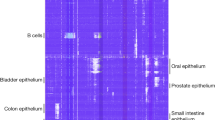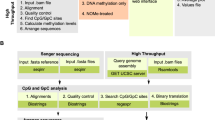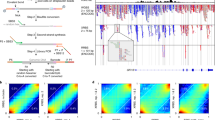Abstract
DNA methylation plays a key role in regulating eukaryotic gene expression. Although mitotically heritable and stable over time, patterns of DNA methylation frequently change in response to cell differentiation, disease and environmental influences. Several methods have been developed to map DNA methylation on a genomic scale. Here, we benchmark four of these approaches by analyzing two human embryonic stem cell lines derived from genetically unrelated embryos and a matched pair of colon tumor and adjacent normal colon tissue obtained from the same donor. Our analysis reveals that methylated DNA immunoprecipitation sequencing (MeDIP-seq), methylated DNA capture by affinity purification (MethylCap-seq), reduced representation bisulfite sequencing (RRBS) and the Infinium HumanMethylation27 assay all produce accurate DNA methylation data. However, these methods differ in their ability to detect differentially methylated regions between pairs of samples. We highlight strengths and weaknesses of the four methods and give practical recommendations for the design of epigenomic case-control studies.
This is a preview of subscription content, access via your institution
Access options
Subscribe to this journal
Receive 12 print issues and online access
$209.00 per year
only $17.42 per issue
Buy this article
- Purchase on Springer Link
- Instant access to full article PDF
Prices may be subject to local taxes which are calculated during checkout





Similar content being viewed by others
References
Bird, A. DNA methylation patterns and epigenetic memory. Genes Dev. 16, 6 (2002).
Baylin, S.B. & Ohm, J.E. Epigenetic gene silencing in cancer—a mechanism for early oncogenic pathway addiction? Nat. Rev. Cancer 6, 107–116 (2006).
Esteller, M. Epigenetics in cancer. N. Engl. J. Med. 358, 1148–1159 (2008).
Feinberg, A.P. & Tycko, B. The history of cancer epigenetics. Nat. Rev. Cancer 4, 143–153 (2004).
Issa, J.P. CpG island methylator phenotype in cancer. Nat. Rev. Cancer 4, 988–993 (2004).
Jones, P.A. & Laird, P.W. Cancer epigenetics comes of age. Nat. Genet. 21, 163–167 (1999).
Richardson, B. Primer: epigenetics of autoimmunity. Nat. Clin. Pract. Rheumatol. 3, 521–527 (2007).
Tobi, E.W. et al. DNA methylation differences after exposure to prenatal famine are common and timing- and sex-specific. Hum. Mol. Genet. 18, 4046–4053 (2009).
Urdinguio, R.G., Sanchez-Mut, J.V. & Esteller, M. Epigenetic mechanisms in neurological diseases: genes, syndromes, and therapies. Lancet Neurol. 8, 1056–1072 (2009).
Bock, C. Epigenetic biomarker development. Epigenomics 1, 99–110 (2009).
Meissner, A. et al. Genome-scale DNA methylation maps of pluripotent and differentiated cells. Nature 454, 766–770 (2008).
Down, T.A. et al. A Bayesian deconvolution strategy for immunoprecipitation-based DNA methylome analysis. Nat. Biotechnol. 26, 779–785 (2008).
Weber, M. et al. Chromosome-wide and promoter-specific analyses identify sites of differential DNA methylation in normal and transformed human cells. Nat. Genet. 37, 853–862 (2005).
Brinkman, A.B. et al. Whole-genome DNA methylation profiling using MethylCap-seq-seq. Methods published online, doi:10.1016/j.ymeth.2010.06.012 (11 June 2010).
Rauch, T. & Pfeifer, G.P. Methylated-CpG island recovery assay: a new technique for the rapid detection of methylated-CpG islands in cancer. Lab. Invest. 85, 1172–1180 (2005).
Serre, D., Lee, B.H. & Ting, A.H. MBD-isolated Genome Sequencing provides a high-throughput and comprehensive survey of DNA methylation in the human genome. Nucleic Acids Res. 38, 391–399 (2010).
Bibikova, M. et al. Genome-wide DNA methylation profiling using Infinium assay. Epigenomics 1, 177–200 (2009).
Eckhardt, F. et al. DNA methylation profiling of human chromosomes 6, 20 and 22. Nat. Genet. 38, 1378–1385 (2006).
Brunner, A.L. et al. Distinct DNA methylation patterns characterize differentiated human embryonic stem cells and developing human fetal liver. Genome Res. 19, 1044–1056 (2009).
Irizarry, R.A. et al. Comprehensive high-throughput arrays for relative methylation (CHARM). Genome Res. 18, 780–790 (2008).
Oda, M. et al. High-resolution genome-wide cytosine methylation profiling with simultaneous copy number analysis and optimization for limited cell numbers. Nucleic Acids Res. 37, 3829–3839 (2009).
Gu, H. et al. Genome-scale DNA methylation mapping of clinical samples at single-nucleotide resolution. Nat. Methods 7, 133–136 (2010).
Cowan, C.A. et al. Derivation of embryonic stem-cell lines from human blastocysts. N. Engl. J. Med. 350, 1353–1356 (2004).
Weisenberger, D.J. et al. Comprehensive DNA methylation analysis on the Illumina Infinium assay platform (Illumina, San Diego, California, USA, 2008). 〈http://www.illumina.com/Documents/products/appnotes/appnote_infinium_methylation.pdf〉. (2008).
Bock, C. et al. Inter-individual variation of DNA methylation and its implications for large-scale epigenome mapping. Nucleic Acids Res. 36, e55 (2008).
Pelizzola, M. et al. MEDME: an experimental and analytical methodology for the estimation of DNA methylation levels based on microarray derived MeDIP-enrichment. Genome Res. 18, 1652–1659 (2008).
Robinson, M.D., Statham, A.L., Speed, T.P. & Clark, S.J. Protocol matters: which methylome are you actually studying? Epigenomics 2, 587 (2010).
Faul, F. et al. G*Power 3: a flexible statistical power analysis program for the social, behavioral, and biomedical sciences. Behav. Res. Methods 39, 175–191 (2007).
Beroukhim, R. et al. The landscape of somatic copy-number alteration across human cancers. Nature 463, 899–905 (2010).
Redon, R. et al. Global variation in copy number in the human genome. Nature 444, 444–454 (2006).
Irizarry, R.A. et al. The human colon cancer methylome shows similar hypo- and hypermethylation at conserved tissue-specific CpG island shores. Nat. Genet. 41, 178–186 (2009).
Hellebrekers, D.M. et al. GATA4 and GATA5 are potential tumor suppressors and biomarkers in colorectal cancer. Clin. Cancer Res. 15, 3990–3997 (2009).
Zhang, W. et al. Epigenetic inactivation of the canonical Wnt antagonist SRY-box containing gene 17 in colorectal cancer. Cancer Res. 68, 2764–2772 (2008).
Tenesa, A. et al. Genome-wide association scan identifies a colorectal cancer susceptibility locus on 11q23 and replicates risk loci at 8q24 and 18q21. Nat. Genet. 40, 631–637 (2008).
Lofton-Day, C. et al. DNA methylation biomarkers for blood-based colorectal cancer screening. Clin. Chem. 54, 414–423 (2008).
Caldwell, G.M. et al. The Wnt antagonist sFRP1 in colorectal tumorigenesis. Cancer Res. 64, 883–888 (2004).
Hirata, H. et al. Wnt antagonist gene DKK2 is epigenetically silenced and inhibits renal cancer progression through apoptotic and cell cycle pathways. Clin. Cancer Res. 15, 5678–5687 (2009).
Ehrlich, M. DNA hypomethylation in cancer cells. Epigenomics 1, 239–259 (2009).
Jurka, J. Repbase update: a database and an electronic journal of repetitive elements. Trends Genet. 16, 418–420 (2000).
Bestor, T.H. & Tycko, B. Creation of genomic methylation patterns. Nat. Genet. 12, 363–367 (1996).
Esteller, M. Cancer epigenomics: DNA methylomes and histone-modification maps. Nat. Rev. Genet. 8, 286–298 (2007).
Jones, P.A. & Baylin, S.B. The epigenomics of cancer. Cell 128, 683–692 (2007).
Feinberg, A.P. Phenotypic plasticity and the epigenetics of human disease. Nature 447, 433–440 (2007).
Manolio, T.A. et al. Finding the missing heritability of complex diseases. Nature 461, 747–753 (2009).
Foley, D.L. et al. Prospects for epigenetic epidemiology. Am. J. Epidemiol. 169, 389–400 (2009).
Heijmans, B.T. et al. The epigenome: archive of the prenatal environment. Epigenetics 4, 526–531 (2009).
Doi, A. et al. Differential methylation of tissue- and cancer-specific CpG island shores distinguishes human induced pluripotent stem cells, embryonic stem cells and fibroblasts. Nat. Genet. 41, 1350–1353 (2009).
Smiraglia, D.J. et al. Excessive CpG island hypermethylation in cancer cell lines versus primary human malignancies. Hum. Mol. Genet. 10, 1413–1419 (2001).
Lister, R. et al. Human DNA methylomes at base resolution show widespread epigenomic differences. Nature 462, 315–322 (2009).
Popp, C. et al. Genome-wide erasure of DNA methylation in mouse primordial germ cells is affected by AID deficiency. Nature 463, 1101–1105 (2010).
Horard, B. et al. Global analysis of DNA methylation and transcription of human repetitive sequences. Epigenetics 4, 339–350 (2009).
Rodriguez, J. et al. Genome-wide tracking of unmethylated DNA Alu repeats in normal and cancer cells. Nucleic Acids Res. 36, 770–784 (2008).
Weisenberger, D.J. et al. Analysis of repetitive element DNA methylation by MethyLight. Nucleic Acids Res. 33, 6823–6836 (2005).
Yoder, J.A., Walsh, C.P. & Bestor, T.H. Cytosine methylation and the ecology of intragenomic parasites. Trends Genet. 13, 335–340 (1997).
Bock, C. et al. CpG island mapping by epigenome prediction. PLoS Comput. Biol. 3, e110 (2007).
Pruitt, K.D., Tatusova, T. & Maglott, D.R. NCBI reference sequences (RefSeq): a curated non-redundant sequence database of genomes, transcripts and proteins. Nucleic Acids Res. 35 (Database issue), D61–D65 (2007).
Smith, Z.D. et al. High-throughput bisulfite sequencing in mammalian genomes. Methods 48, 226–232 (2009).
Rakyan, V.K. et al. An integrated resource for genome-wide identification and analysis of human tissue-specific differentially methylated regions (tDMRs). Genome Res. 18, 1518–1529 (2008).
Li, H., Ruan, J. & Durbin, R. Mapping short DNA sequencing reads and calling variants using mapping quality scores. Genome Res. 18, 1851–1858 (2008).
Bock, C. & Lengauer, T. Computational epigenetics. Bioinformatics 24, 1–10 (2008).
Park, P.J. ChIP-seq: advantages and challenges of a maturing technology. Nat. Rev. Genet. 10, 669–680 (2009).
Storey, J.D. & Tibshirani, R. Statistical significance for genomewide studies. Proc. Natl. Acad. Sci. USA 100, 9440–9445 (2003).
Heintzman, N.D. et al. Histone modifications at human enhancers reflect global cell-type-specific gene expression. Nature 459, 108–112 (2009).
Hajkova, P. et al. DNA-methylation analysis by the bisulfite-assisted genomic sequencing method. Methods Mol. Biol. 200, 143–154 (2002).
Li, L.C. & Dahiya, R. MethPrimer: designing primers for methylation PCRs. Bioinformatics 18, 1427–1431 (2002).
Bock, C. et al. BiQ Analyzer: visualization and quality control for DNA methylation data from bisulfite sequencing. Bioinformatics 21, 4067–4068 (2005).
Acknowledgements
We thank A. Crenshaw and M. Parkin (Broad Institute) for assistance with the Infinium assay and K. Halachev (Max Planck Institute for Informatics) for the provision of genome annotation files. C.B. is supported by a Feodor Lynen Fellowship from the Alexander von Humboldt Foundation. A.B.B. is supported by the Dutch Cancer Foundation (KWF, grant KUN 2008-4130). A.M. is supported by the Massachusetts Life Science Center and the Pew Charitable Trusts. The described work was in part funded by the Pew Charitable Trusts, the US National Institutes of Health Roadmap Initiative on Epigenomics (U01ES017155) and the European Union's CANCERDIP project (HEALTH-F2-2007-200620).
Author information
Authors and Affiliations
Contributions
C.B., E.M.T. and A.M. conceived and designed the study; E.M.T., A.B.B., F.S. and H.G. performed the experiments; C.B., F.M. and N.J. analyzed the data; C.B., A.G., H.G.S. and A.M. interpreted the results; and C.B. and A.M. wrote the paper.
Corresponding authors
Ethics declarations
Competing interests
The authors declare no competing financial interests.
Supplementary information
Supplementary Text and Figures
Supplementary Figs. 1–12 (PDF 2789 kb)
Supplementary Data 1
Validation of method-specific DMRs by clonal bisulfite sequencing (PDF 804 kb)
Supplementary Data 2
DNA methylation map of prototypic repeat sequences (PDF 4723 kb)
Supplementary Data 3
Differential DNA methylation of prototypic repeat sequences (PDF 3239 kb)
Rights and permissions
About this article
Cite this article
Bock, C., Tomazou, E., Brinkman, A. et al. Quantitative comparison of genome-wide DNA methylation mapping technologies. Nat Biotechnol 28, 1106–1114 (2010). https://doi.org/10.1038/nbt.1681
Published:
Issue Date:
DOI: https://doi.org/10.1038/nbt.1681
This article is cited by
-
Epigenetics and stroke: role of DNA methylation and effect of aging on blood–brain barrier recovery
Fluids and Barriers of the CNS (2023)
-
EpiTyping: analysis of epigenetic aberrations in parental imprinting and X-chromosome inactivation using RNA-seq
Nature Protocols (2023)
-
Evaluation of whole-genome DNA methylation sequencing library preparation protocols
Epigenetics & Chromatin (2021)
-
DNA methylation analysis reveals epimutation hotspots in patients with dilated cardiomyopathy-associated laminopathies
Clinical Epigenetics (2021)
-
Epigenetic interaction between UTX and DNMT1 regulates diet-induced myogenic remodeling in brown fat
Nature Communications (2021)



